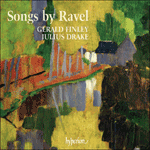With
Histoires naturelles, on prose poems by Jules Renard, Ravel’s playfulness tipped over into controversy and the premiere in January 1907 was a noisy affair. His chief crime was to eliminate some of the final mute ‘e’s, in the popular style of the café concert. In the opening
Le paon, the peacock’s pomposity is undercut by the shortening of ‘la fi-an-cé-e n’ar-ri-ve pas’ to ‘la fian-cé’ n’ar-riv’ pas’. There was even shouting when, in
Le grillon, as the cricket took a rest (‘Il se repose’) Ravel’s music came to a sudden halt. Equally disconcerting, after the busy-busy movements of the cricket (which some commentators have likened to Ravel himself), is the magical, visionary epilogue in D flat major, where he later admitted he had deliberately allowed his Romantic inclinations to surface. Debussy, who by 1907 was no longer a friend, complained of the ‘factitious Americanism’ of the more light-hearted passages in the cycle, but even he had to admit
Le cygne was beautiful music. The piano part is marked ‘very gentle and enveloped in pedal’ and the setting of seven semiquavers in the right hand against two in the left makes for effortless progress, quite different from the cricket’s precise gestures. Ravel dedicated the song to Misia Godebska, a mover and shaker in Parisian musical circles who was soon to become Diaghilev’s right-hand woman, and it could be that Ravel saw her as the swan, gliding smoothly through society with her eye fixed on the main chance.
‘Not a bite, this evening’, complains the fisherman at the start of Le martin-pêcheur. The cool, diamond-like, almost Messiaenic chords do not react (unlike the 1907 audience which here rose to an apogee of outrage) but go their way ‘as slowly as possible’. Here is a music of silence, the singer somehow conveying breathlessness while breathing deeply. Pierre Bernac called it ‘the most difficult mélodie of the set’. But for the pianist the worst moments come in La pintade. With its gruppetti and shrill, explosive acciaccaturas, it looks back not just to Alborada del gracioso but to another fowl-piece, ‘Baba-Yaga’ from Musorgsky’s Pictures from an Exhibition. It makes an entertaining and aesthetically uncomplicated finale to the set, but also displays Ravel’s aggressive side.
from notes by Roger Nichols © 2009
Dans
Histoires naturelles, sur des poèmes en prose de Jules Renard, le caractère enjoué de Ravel a basculé dans la controverse et la première exécution, en janvier 1907, a été tumultueuse. Son principal crime a consisté à éliminer quelques-uns des «e» muets finaux, dans le style populaire du café concert. Dans
Le paon initial, le ton pompeux du paon est sapé par le raccourcissement de «la fi-an-cé-e n’ar-ri-ve pas» en «la fian-cé’ n’ar-riv’ pas». Il y a même eu des cris lorsque, dans
Le grillon, alors que le grillon se repose («Il se repose»), la musique de Ravel s’est soudain arrêtée. Tout aussi déconcertant, après les mouvements très animés du grillon (que certains critiques ont comparé à Ravel lui-même), survient un épilogue visionnaire et magique en ré bémol majeur, où Ravel a admis plus tard s’être délibérément abandonné à ses penchants romantiques. Debussy qui, en 1907, n’était plus son ami, a déploré «l’américanisme voulu» des passages les plus enjoués du cycle, mais il a quand même dû admettre que
Le cygne était une magnifique musique. La partie de piano est marquée «très doux et enveloppé à la pédale» et l’opposition entre sept doubles croches à la main droite et deux à la main gauche permet une progression naturelle, très différente des gestes précis du grillon. Ravel a dédié cette mélodie à Misia Godebska, une femme qui jouait un rôle actif dans les milieux musicaux parisiens et qui allait bientôt devenir le bras droit de Diaghilev; il n’est pas impossible que Ravel l’ait imaginée sous les traits du cygne, glissant en douceur dans la haute société et tirant profit de toutes les situations.
«Ça n’a pas mordu, ce soir», se plaint le pêcheur au début du Martin-pêcheur. Les accords froids comme du diamant, presque messiaeniques ne réagissent pas (contrairement à l’auditoire de 1907, qui était parvenu au sommet de son indignation), mais poursuivent leur chemin «on ne peut plus lent». On a ici une musique de silence, la chanteuse traduisant l’essoufflement en respirant profondément. Pour Pierre Bernac, c’était «la mélodie la plus difficile du recueil». Mais pour le pianiste, les pires moments se trouvent dans La pintade. Avec ses gruppetti et ses acciaccaturas explosives et stridentes, elle se réfère non seulement à l’Alborada del gracioso, mais aussi à une autre pièce où il est question de volailles, «Baba-Yaga» dans les Tableaux d’une exposition de Moussorgski. Elle fournit à l’ensemble un finale divertissant et simple sur le plan esthétique, mais montre aussi le côté agressif de Ravel.
extrait des notes rédigées par Roger Nichols © 2009
Français: Marie-Stella Pâris
In
Histoires naturelles, Vertonungen von Prosa-Gedichten von Jules Renard, kippte Ravels spielerischer Zug ins Kontroverse und die Premiere im Januar 1907 war eine laute Angelegenheit. Sein größtes Vergehen war es, einige stumme „e“s an Wortenden, gemäß dem populären Konzertstil in den Cafés, auszulassen. Im ersten Lied,
Le paon, wird die Großspurigkeit eines Pfaus durch die Verkürzung von „la fi-an-cé-e n’ar-ri-ve pas“ zu „la fian-cé’ n’ar-riv’ pas“ untergraben. Es wurde sogar gerufen, als die Grille in
Le grillon sich eine Pause gönnte („Il se repose“) und Ravels Musik plötzlich verstummte. Ebenso verwirrend ist—nach den äußerst betriebsamen Bewegungen der Grille (die mit Ravel selbst verglichen worden sind)—der zauberhafte, visionäre Epilog in Des-Dur, von dem er später zugab, dass er hier mit Absicht seinen romantischen Hang hatte zum Vorschein kommen lassen. Debussy, der 1907 nicht mehr mit ihm befreundet war, beschwerte sich über den „gekünstelten Amerikanismus“ der unbeschwerteren Passagen des Zyklus, doch selbst er musste zugeben, dass
Le cygne ein gelungenes Werk war. Die Klavierstimme ist mit „sehr sanft und mit dem Pedal umhüllt“ überschrieben und die sieben Sechzehntel in der rechten Hand, die gegen zwei in der linken gesetzt sind, sorgen für ein müheloses Fortschreiten, das sich deutlich von den präzisen Gesten der Grille abhebt. Ravel widmete das Lied Misia Godebska, eine treibende Kraft im Pariser Musikleben, die bald die rechte Hand von Diaghilew werden sollte, und es kann gut sein, dass Ravel sie als einen Schwan betrachtete, der sanft durch die Pariser Gesellschaft glitt, die Augen fest auf das Ziel geheftet.
„Nichts hat angebissen heute Abend“, beschwert sich der Fischer am Anfang von Le martin-pêcheur. Die kühlen, diamantartigen, fast an Messiaen erinnernden Akkorde reagieren nicht (anders als das Publikum 1907, das hier einen Gipfel der Entrüstung erreichte), sondern schreiten „so langsam wie möglich“ voran. Es ist dies eine Musik der Stille und der Sänger muss eine Atemlosigkeit ausdrücken, während er selbst tief atmet. Pierre Bernac bezeichnete sie als „die schwierigste Melodie des Zyklus“. Für den Pianisten kommen die schlimmsten Passagen jedoch in La pintade. Die Gruppetti und schrillen, explosiven Acciaccaturen beziehen sich nicht nur auf Alborada del gracioso, sondern auch auf „Baba-Yaga“ aus den Bildern einer Ausstellung von Mussorgsky. Es ist ein unterhaltsames und ästhetisch unkompliziertes Finale, zeigt jedoch den Komponisten auch von seiner aggressiven Seite.
aus dem Begleittext von Roger Nichols © 2009
Deutsch: Viola Scheffel


 Ravel: Songs
Ravel: Songs Ravel: The Complete Songs
Ravel: The Complete Songs
